Functions and algebra: Use a variety of techniques to sketch and interpret information from graphs of functions
Unit 3: Sketch hyperbolic functions
Dylan Busa
Unit outcomes
By the end of this unit you will be able to:
- Determine the domain and range of hyperbolic functions of the form [latex]\scriptsize y=\displaystyle \frac{a}{{(x+p)}}+q[/latex].
- Find the asymptotes of hyperbolic functions of the form [latex]\scriptsize y=\displaystyle \frac{a}{{(x+p)}}+q[/latex].
- Find the axes of symmetry of hyperbolic functions of the form [latex]\scriptsize y=\displaystyle \frac{a}{{(x+p)}}+q[/latex].
- Find the intercepts with the axes of hyperbolic functions of the form [latex]\scriptsize y=\displaystyle \frac{a}{{(x+p)}}+q[/latex].
- Sketch hyperbolic functions of the form [latex]\scriptsize y=\displaystyle \frac{a}{{(x+p)}}+q[/latex].
What you should know
Before you start this unit, make sure you can:
- Solve equations of the form [latex]\scriptsize y=\displaystyle \frac{a}{x}+q[/latex].
- Plot hyperbolic functions of the form [latex]\scriptsize y=\displaystyle \frac{a}{x}+q[/latex].
- Determine the x- and y-intercepts of a hyperbolic function of the form [latex]\scriptsize y=\displaystyle \frac{a}{x}+q[/latex].
- Determine the domain and range of a hyperbolic function of the form [latex]\scriptsize y=\displaystyle \frac{a}{x}+q[/latex].
- Determine the asymptotes of hyperbolic functions of the form [latex]\scriptsize y=\displaystyle \frac{a}{x}+q[/latex].
Refer to level 2 subject outcome 2.1 unit 3 if you require assistance with any of these skills.
Introduction
In level 2 we were introduced to the hyperbolic function of the form [latex]\scriptsize y=\displaystyle \frac{a}{x}+q[/latex] and the graph of the function called a hyperbola. We learnt that these types of functions and their graphs are widely used in the design of lenses and mirrors because of their ability to focus light to a single point.
We discovered that the hyperbola has two arms and the shape and position of these are affected by the values of [latex]\scriptsize a[/latex] and [latex]\scriptsize q[/latex].
Take note!
The effect of [latex]\scriptsize q[/latex]:
- if [latex]\scriptsize q \gt 0[/latex], the function is shifted up by [latex]\scriptsize q[/latex] units
- if [latex]\scriptsize q \lt 0[/latex], the function is shifted down by [latex]\scriptsize q[/latex] units
- horizontal asymptote is the line [latex]\scriptsize y=q[/latex]
- vertical asymptote is the y-axis or the line [latex]\scriptsize x=0[/latex]
- axes of symmetry are [latex]\scriptsize y=x+q[/latex] and [latex]\scriptsize y=-x+q[/latex].
The effect of [latex]\scriptsize a[/latex]:
if [latex]\scriptsize a \gt 0[/latex], the function lies in the first and third quadrants
if [latex]\scriptsize a \lt 0[/latex], the function lies in the second and fourth quadrants
as the value of [latex]\scriptsize a[/latex] gets closer to zero (from the positive or negative side), the graph gets closer to the axes and/or asymptotes.

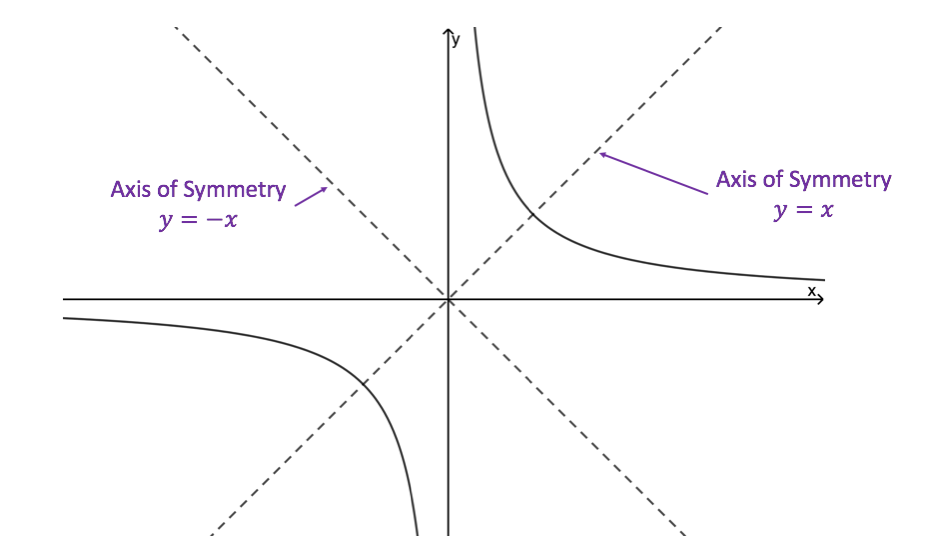
Note
If you have access to the internet, visit this interactive simulation.
Here you will find a hyperbolic function of the form [latex]\scriptsize y=\displaystyle \frac{a}{x}+q[/latex] with sliders to change the values of [latex]\scriptsize a[/latex] and [latex]\scriptsize q[/latex]. Spend some time playing with it to make sure that you understand how changing the values of [latex]\scriptsize a[/latex] and [latex]\scriptsize q[/latex] affects the shape and location of the hyperbola of the form [latex]\scriptsize y=\displaystyle \frac{a}{x}+q[/latex].
The hyperbolic function of the form [latex]\scriptsize y=\displaystyle \frac{a}{{(x+p)}}+q[/latex]
We know that the value of [latex]\scriptsize q[/latex] in [latex]\scriptsize y=\displaystyle \frac{a}{x}+q[/latex] shifts the graph vertically up or down. Now, let’s investigate the effect of [latex]\scriptsize p[/latex] in [latex]\scriptsize y=\displaystyle \frac{a}{{(x+p)}}+q[/latex]. Based on your knowledge of the effect of [latex]\scriptsize p[/latex] in the turning point form of the quadratic function [latex]\scriptsize y=a{{(x+p)}^{2}}+q[/latex], What do you think this effect will be?
Figure 3 shows the graphs of three hyperbolic functions, [latex]\scriptsize f(x)=\displaystyle \frac{2}{x}[/latex], [latex]\scriptsize g(x)=\displaystyle \frac{2}{{x+2}}[/latex] and [latex]\scriptsize h(x)=\displaystyle \frac{2}{{x-3}}[/latex]. We can see that because [latex]\scriptsize a \gt 0[/latex] in each case, all three graphs lie in the first and third quadrants and because [latex]\scriptsize q=0[/latex], all three graphs have horizontal asymptotes of [latex]\scriptsize y=0[/latex].
But what is different? Can you see that the vertical asymptote of [latex]\scriptsize f(x)[/latex] is the y-axis (the line [latex]\scriptsize x=0[/latex]) while the graph of [latex]\scriptsize g(x)[/latex] has been shifted two units to the left of [latex]\scriptsize f(x)[/latex] (its vertical asymptote is [latex]\scriptsize x=-2[/latex]) and [latex]\scriptsize h(x)[/latex] has been shifted three unit to the right (its vertical asymptote is [latex]\scriptsize x=3[/latex])?
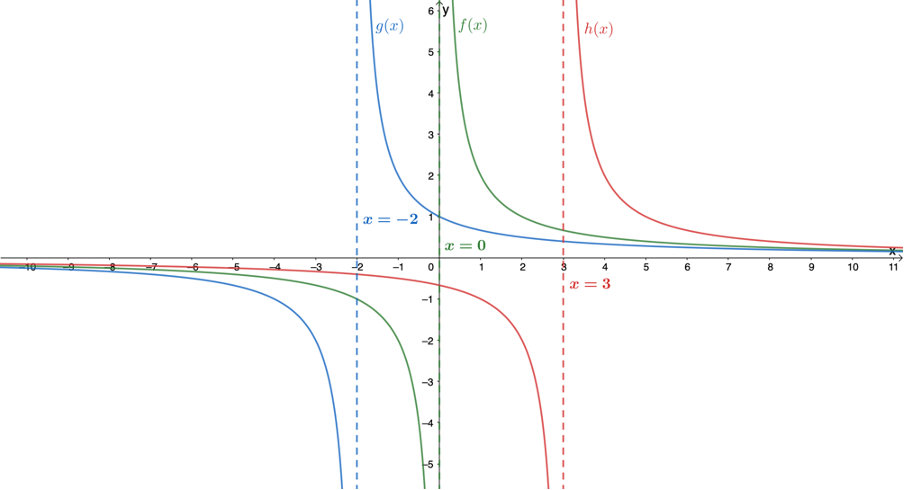
The value of [latex]\scriptsize p[/latex] in [latex]\scriptsize y=\displaystyle \frac{a}{{(x+p)}}+q[/latex] is therefore responsible for a horizontal shift of the graph.
- If [latex]\scriptsize p \gt 0[/latex], the graph is shifted [latex]\scriptsize p[/latex] units to the left.
- If [latex]\scriptsize p \lt 0[/latex], the graph is shifted [latex]\scriptsize p[/latex] units to the right.
This horizontal shift means a shift of the vertical asymptote of the graph. The vertical asymptote is the line [latex]\scriptsize x=-p[/latex].
Take note!
In the function [latex]\scriptsize y=\displaystyle \frac{a}{{(x+p)}}+q[/latex]:
- the horizontal asymptote is the line [latex]\scriptsize y=q[/latex]
- the vertical asymptote is the line [latex]\scriptsize x=-p[/latex].
Domain and range of the hyperbolic function of the form [latex]\scriptsize y=\displaystyle \frac{a}{{(x+p)}}+q[/latex]
We can see that in [latex]\scriptsize y=\displaystyle \frac{a}{{(x+p)}}+q[/latex], [latex]\scriptsize (x+p)\ne 0[/latex] and therefore [latex]\scriptsize x\ne -p[/latex]. Therefore, the domain is [latex]\scriptsize \{x|x\in \mathbb{R},x\ne -p\}[/latex].
If [latex]\scriptsize x\ne -p[/latex], then:
[latex]\scriptsize \begin{align*}y & =\displaystyle \frac{a}{{(x+p)}}+q\\\therefore y-q & =\displaystyle \frac{a}{{(x+p)}}\\\therefore (y-q)(x+p) & =a\\\therefore (x+p) & =\displaystyle \frac{a}{{(y-q)}}\\\therefore y-q & \ne 0\\\therefore y & \ne q\end{align*}[/latex]
So, the range is [latex]\scriptsize \{y|y\in \mathbb{R},y\ne q\}\text{ }[/latex]
Take note!
For [latex]\scriptsize y=\displaystyle \frac{a}{{(x+p)}}+q[/latex]:
- the domain is [latex]\scriptsize \{x|x\in \mathbb{R},x\ne -p\}\text{ }[/latex]
- the range is [latex]\scriptsize \{y|y\in \mathbb{R},y\ne q\}\text{ }[/latex].
Note that the restrictions on the domain and range determine the vertical and horizontal asymptotes.
Example 3.1
Determine the domain, range and asymptotes of [latex]\scriptsize s(x)=\displaystyle \frac{4}{{(x-2)}}+\displaystyle \frac{1}{2}[/latex].
Solution
[latex]\scriptsize \begin{align*}x-2 & \ne 0\\\therefore x & \ne 2\end{align*}[/latex]
Domain is [latex]\scriptsize \{x|x\in \mathbb{R},x\ne 2\}\text{ }[/latex]
Vertical asymptote is the line [latex]\scriptsize x=2[/latex].
Let [latex]\scriptsize s(x)[/latex] be [latex]\scriptsize y[/latex]:
[latex]\scriptsize \displaystyle \begin{align*}y & =\displaystyle \frac{4}{{(x-2)}}+\displaystyle \frac{1}{2}\\\therefore y-\displaystyle \frac{1}{2} & =\displaystyle \frac{4}{{(x-2)}}\\\therefore x-2 & =\displaystyle \frac{4}{{\left( {y-\displaystyle \frac{1}{2}} \right)}}\\\therefore y-\displaystyle \frac{1}{2} & \ne 0\\\therefore y & \ne \displaystyle \frac{1}{2}\end{align*}[/latex]
Range is [latex]\scriptsize \{y|y\in \mathbb{R},y\ne \displaystyle \frac{1}{2}\}\text{ }[/latex]
Horizontal asymptote is the line [latex]\scriptsize y=\displaystyle \frac{1}{2}[/latex].
Take note!
The vertical asymptote of a hyperbola of the form [latex]\scriptsize y=\displaystyle \frac{a}{{x+p}}+q[/latex] is the line [latex]\scriptsize x=-p[/latex].
The horizontal asymptote of a hyperbola of the form [latex]\scriptsize y=\displaystyle \frac{a}{{x+p}}+q[/latex] is the line [latex]\scriptsize y=q[/latex].
Exercise 3.1
Determine the domain, range and asymptotes of each of the following functions:
- [latex]\scriptsize y=-\displaystyle \frac{3}{{x-3}}-1[/latex]
- [latex]\scriptsize x=\displaystyle \frac{7}{{y+4}}+1[/latex]
- [latex]\scriptsize (x+2)(y-3)=\displaystyle \frac{3}{2}[/latex]
The full solutions are at the end of the unit.
Intercepts
When the values of [latex]\scriptsize p[/latex] and [latex]\scriptsize q[/latex] in [latex]\scriptsize y=\displaystyle \frac{a}{{(x+p)}}+q[/latex] are zero, the graph has vertical and horizontal asymptotes that are the y-axis and x-axis respectively. In this case, the graph never crosses or even touches either of the axes and so there are no intercepts with the axes. However, when [latex]\scriptsize p[/latex] and/or [latex]\scriptsize q[/latex] are not equal to zero and the asymptotes shift, then there are intercepts with the axes.
To calculate these intercepts, we use the same techniques we have always used:
- to calculate the y-intercept, we let [latex]\scriptsize x=0[/latex]
- to calculate the x-intercept, we let [latex]\scriptsize y=0[/latex].
Example 3.2
Determine the intercepts with the axes of [latex]\scriptsize j(x)=-\displaystyle \frac{3}{{x+4}}-3[/latex].
Solution
Step 1: Find the x-intercepts
x-intercepts (let [latex]\scriptsize y=0[/latex]):
[latex]\scriptsize \begin{align*}0 & =-\displaystyle \frac{3}{{x+4}}-3\\\therefore \displaystyle \frac{3}{{x+4}} & =-3\\\therefore 3 & =-3(x+4)\\\therefore 3 & =-3x-12\\\therefore 3x & =-15\\\therefore x & =-5\end{align*}[/latex]
The x-intercept is the point [latex]\scriptsize (-5,0)[/latex].
Step 2: Find the y-intercepts
y-intercepts (let [latex]\scriptsize x=0[/latex]):
[latex]\scriptsize \begin{align*}j(0) & =-\displaystyle \frac{3}{{0+4}}-3\\\therefore j(0) & =-\displaystyle \frac{3}{4}-3\\ & =-\displaystyle \frac{3}{4}-\displaystyle \frac{{12}}{4}\\ & =-\displaystyle \frac{{15}}{4}\end{align*}[/latex]
The y-intercept is the point [latex]\scriptsize (0,-\displaystyle \frac{{15}}{4})[/latex].
Exercise 3.2
Determine the intercepts with the axes of the following functions:
- [latex]\scriptsize f(x)=-\displaystyle \frac{2}{{\left( {x+\displaystyle \frac{1}{2}} \right)}}-3[/latex]
- [latex]\scriptsize y-7=\displaystyle \frac{3}{{x-1}}[/latex]
- [latex]\scriptsize g(x)+\displaystyle \frac{1}{3}=\displaystyle \frac{4}{{(x-2)}}[/latex]
The full solutions are at the end of the unit.
Axes of symmetry
We know that the hyperbola has two axes of symmetry. One has a gradient of [latex]\scriptsize 1[/latex] and the other a gradient of [latex]\scriptsize -1[/latex]. Therefore, they intersect each other at right angles. But where do they intersect each other?
Look at Figures 4, 5 and 6 which show the functions [latex]\scriptsize f(x)=\displaystyle \frac{2}{x}[/latex], [latex]\scriptsize g(x)=\displaystyle \frac{2}{{(x+2)}}+1[/latex] and [latex]\scriptsize h(x)=\displaystyle \frac{2}{{(x-3)}}-1[/latex]. In each case, at what point do the axes of symmetry of the function intersect? How does this point relate to the values of [latex]\scriptsize p[/latex] and [latex]\scriptsize q[/latex] in each case?
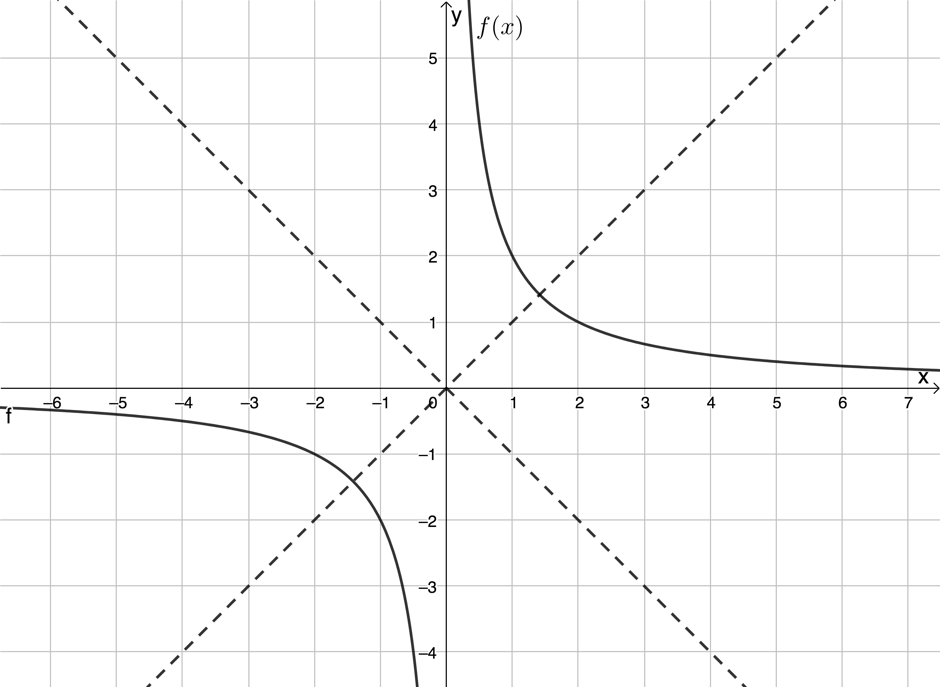
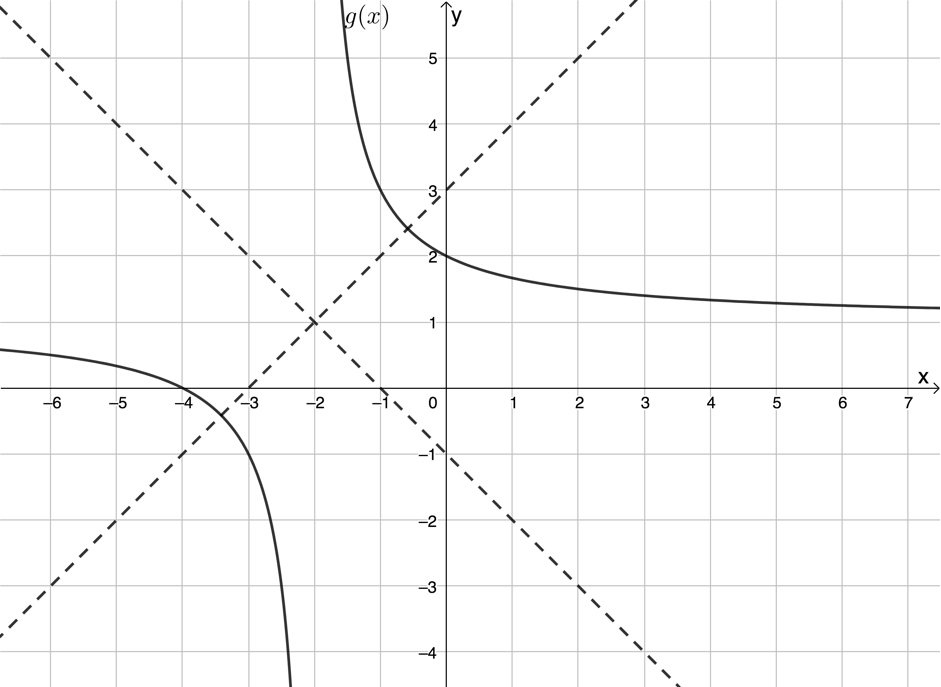

In each case, we can see that the axes of symmetry intersect at the point [latex]\scriptsize (-p,q)[/latex]. This is, in fact, the same point where the two asymptotes intersect and so the point of intersection can also be thought of in terms of the values of the asymptotes.
Now, if the axes of symmetry have gradients of [latex]\scriptsize 1[/latex] and [latex]\scriptsize -1[/latex] , we know that their equations will be [latex]\scriptsize y=x+{{c}_{1}}[/latex] and [latex]\scriptsize y=-x+{{c}_{2}}[/latex] respectively. Therefore, all we need to do to find the values of [latex]\scriptsize {{c}_{1}}[/latex] and [latex]\scriptsize {{c}_{2}}[/latex] is substitute the point [latex]\scriptsize (-p,q)[/latex] into each equation.
Example 3.3
Determine the equations of the axes of symmetry of [latex]\scriptsize f(x)=-\displaystyle \frac{3}{{x-3}}+2[/latex].
Solution
Step 1: Determine where the axes of symmetry intersect
The point where the axes of symmetry intersect is [latex]\scriptsize (-(-3),2)[/latex] or [latex]\scriptsize (3,2)[/latex].
Step 2: Substitute this point into the equations of the two axes of symmetry
Substitute this point into [latex]\scriptsize y=x+{{c}_{1}}[/latex]:
[latex]\scriptsize \begin{align*}2 & =3+{{c}_{1}}\\\therefore {{c}_{1}} & =-1\end{align*}[/latex]
Substitute this point into [latex]\scriptsize y=-x+{{c}_{2}}[/latex]:
[latex]\scriptsize \begin{align*}2 & =-3+{{c}_{2}}\\\therefore {{c}_{2}} & =5\end{align*}[/latex]
Step 3: Write the final solution
The equations of the axes of symmetry are [latex]\scriptsize y=x-1[/latex] and [latex]\scriptsize y=-x+5[/latex]
Exercise 3.3
Determine the equations of the axes of symmetry of the following functions:
- [latex]\scriptsize b(x)=\displaystyle \frac{4}{{x-1}}+2[/latex]
- [latex]\scriptsize (y-2)(x+3)=2[/latex]
The full solutions are at the end of the unit.
Take note!
The axes of symmetry of a hyperbola of form [latex]\scriptsize y=\displaystyle \frac{a}{{x+p}}+q[/latex] are always straight lines with equations [latex]\scriptsize y=x+{{c}_{1}}[/latex] and [latex]\scriptsize y=-x+{{c}_{2}}[/latex].
The axes of symmetry of a hyperbola of form [latex]\scriptsize y=\displaystyle \frac{a}{{x+p}}+q[/latex] intersect at the point [latex]\scriptsize (-p,q)[/latex].
Sketch the hyperbolic function [latex]\scriptsize y=\displaystyle \frac{a}{{(x+p)}}+q[/latex]
Now that we are able to determine all the characteristics of the hyperbolic function of the form [latex]\scriptsize y=\displaystyle \frac{a}{{(x+p)}}+q[/latex], we can sketch its graph.
Example 3.4
Draw a sketch of [latex]\scriptsize f(x)=\displaystyle \frac{6}{{x+2}}-1[/latex].
Solution
First make sure that the function is in the standard form, i.e. in the form [latex]\scriptsize y=\displaystyle \frac{a}{{(x+p)}}+q[/latex].
To draw an accurate sketch of a hyperbola we need four key pieces of information:
- whether [latex]\scriptsize a \gt 0[/latex] or [latex]\scriptsize a \lt 0[/latex] to determine if the graph lies in the first and third or second and fourth quadrants
- the asymptotes
- the axes of symmetry
- the intercepts with the axes (if these exist).
Step 1: Determine the quadrants
[latex]\scriptsize a \gt 0[/latex]. Therefore the graph will lie in the first and third quadrants.
Step 2: Find the asymptotes
[latex]\scriptsize f(x)=\displaystyle \frac{6}{{x+2}}-1[/latex]
Therefore the vertical asymptote is the line [latex]\scriptsize x=-2[/latex] and the horizontal asymptote is the line [latex]\scriptsize y=-1[/latex].
Step 3: Find the axes of symmetry
The axes of symmetry intersect at the point [latex]\scriptsize (-2,-1)[/latex].
Substitute [latex]\scriptsize (-2,-1)[/latex] into [latex]\scriptsize y=x+{{c}_{1}}[/latex]:
[latex]\scriptsize \begin{align*}-1 & =-2+{{c}_{1}}\\\therefore {{c}_{1}} & =1\end{align*}[/latex]
The A/S is [latex]\scriptsize y=x+1[/latex]
Substitute [latex]\scriptsize (-2,-1)[/latex] into [latex]\scriptsize y=-x+{{c}_{2}}[/latex]:
[latex]\scriptsize \begin{align*}-1 & =2+{{c}_{2}}\\\therefore {{c}_{2}} & =-3\end{align*}[/latex]
The A/S is [latex]\scriptsize y=-x-3[/latex]
Step 4: Find the intercepts with the axes (if these exist)
As neither of the asymptotes is an axis, both an x- and a y-intercept exist.
x-intercept (let [latex]\scriptsize y=0[/latex]):
[latex]\scriptsize \begin{align*}0 & =\displaystyle \frac{6}{{x+2}}-1\\\therefore \displaystyle \frac{6}{{x+2}} & =1\\\therefore x+2 & =6\\\therefore x &=4\end{align*}[/latex]
x-intercept is the point [latex]\scriptsize (4,0)[/latex]
y-intercept (let [latex]\scriptsize x=0[/latex]):
[latex]\scriptsize \begin{align*}f(0) & =\displaystyle \frac{6}{{0+2}}-1\\\therefore f(0) & =2\end{align*}[/latex]
y-intercept is the point [latex]\scriptsize (0,2)[/latex]
Note: If intercepts with the axes do not exist (i.e. the values of [latex]\scriptsize p[/latex] and/or [latex]\scriptsize q[/latex] are zero), find two other points on the graph to help you get the right shape.
Step 5: Make a neat sketch
Draw in and label the asymptotes and axes of symmetry. Mark the intercepts with the axes (if these exist) or the other points on the graph you found. Noting the value of [latex]\scriptsize a[/latex] and the quadrants in which the graph exists, draw a smooth hyperbola passing through the points, symmetrical about the axes of symmetry and approaching the asymptotes.
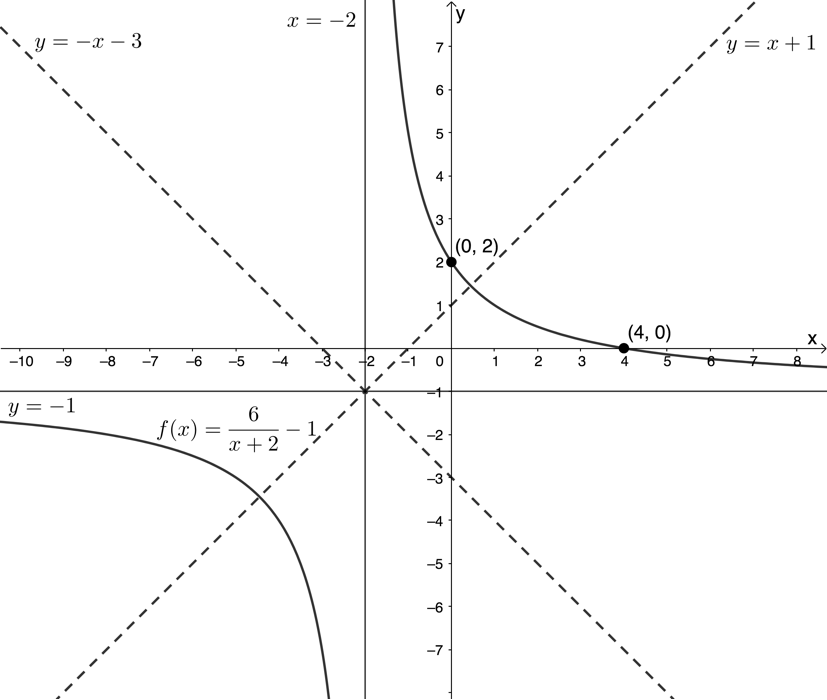
Note
If you have an internet connection visit this online hyperbola simulation.
Here you will find a hyperbolic function of the form [latex]\scriptsize y=\displaystyle \frac{a}{{(x+p)}}+q[/latex] with sliders to change the values of [latex]\scriptsize a[/latex], [latex]\scriptsize p[/latex] and [latex]\scriptsize q[/latex]. This helps you see the effects of these on the shape and the position of the graph as well as the values of the asymptotes, axes of symmetry and intercepts with the axes.
Summary
In this unit you have learnt the following:
- The value of [latex]\scriptsize p[/latex] in [latex]\scriptsize y=\displaystyle \frac{a}{{(x+p)}}+q[/latex] shifts the graph horizontally and also changes the value of the vertical asymptote.
- How to determine the asymptotes, domain and range of hyperbolic functions of the form [latex]\scriptsize y=\displaystyle \frac{a}{{(x+p)}}+q[/latex].
- How to determine the equations of the axes of symmetry of a hyperbolic function of the form [latex]\scriptsize y=\displaystyle \frac{a}{{(x+p)}}+q[/latex].
- How to determine the intercepts with the axes of a hyperbolic function of the form [latex]\scriptsize y=\displaystyle \frac{a}{{(x+p)}}+q[/latex].
- How to use the above information to make an accurate sketch of a hyperbolic function of the form [latex]\scriptsize y=\displaystyle \frac{a}{{(x+p)}}+q[/latex].
Unit 3: Assessment
Suggested time to complete: 30 minutes
- Given [latex]\scriptsize g(x)=\displaystyle \frac{6}{{x-2}}+1[/latex]
- Determine the asymptote(s) of [latex]\scriptsize g(x)[/latex].
- For which values of [latex]\scriptsize x[/latex] is the function [latex]\scriptsize g(x)[/latex] undefined?
- Draw the graph of [latex]\scriptsize g(x)[/latex].
- Determine [latex]\scriptsize g(1)[/latex].
- What is the domain and range of [latex]\scriptsize g(x)[/latex]?
- Given [latex]\scriptsize f(x)-2=\displaystyle \frac{2}{{x-4}}[/latex]
- Determine the asymptote(s) of [latex]\scriptsize f(x)[/latex].
- Determine the x- and y-intercepts of [latex]\scriptsize f(x)[/latex].
- Draw the graph of[latex]\scriptsize f(x)[/latex].
- Determine[latex]\scriptsize f(-1)[/latex].
- What are the domain and range of [latex]\scriptsize f(x)[/latex]?
The full solutions are at the end of the unit.
Unit 3: Solutions
Exercise 3.1
- .
[latex]\scriptsize y=-\displaystyle \frac{3}{{x-3}}-1[/latex]
Domain: [latex]\scriptsize \{x|x\in \mathbb{R},x\ne 3\}\text{ }[/latex]
Vertical asymptote is the line [latex]\scriptsize x=3[/latex]
Range: [latex]\scriptsize \{y|y\in \mathbb{R},x\ne -1\}\text{ }[/latex]
Horizontal asymptote is the line [latex]\scriptsize y=-1[/latex] - .
[latex]\scriptsize \begin{align*}x&=\displaystyle \frac{7}{{y+4}}+1\\ \therefore x-1&=\displaystyle \frac{7}{{y+4}}\\ \therefore y+4&=\displaystyle \frac{7}{{x-1}}\\ \therefore y&=\displaystyle \frac{7}{{x-1}}-4\end{align*}[/latex]
Domain: [latex]\scriptsize \{x|x\in \mathbb{R},x\ne 1\}\text{ }[/latex]
Vertical asymptote is the line [latex]\scriptsize x=1[/latex]
Range: [latex]\scriptsize \{y|y\in \mathbb{R},x\ne -4\}\text{ }[/latex]
Horizontal asymptote is the line [latex]\scriptsize y=-4[/latex] - .
[latex]\scriptsize \begin{align*} (x+2)(y-3)&=\displaystyle \frac{3}{2}\\ \therefore y-3&=\displaystyle \frac{\displaystyle \frac{3}{2}}{(x+2)}\\ \therefore y&=\displaystyle \frac{\displaystyle \frac{3}{2}}{(x+2)}+3 \end{align*}[/latex]
Domain: [latex]\scriptsize \{x|x\in \mathbb{R},x\ne -2\}\text{ }[/latex]
Vertical asymptote is the line [latex]\scriptsize x=-2[/latex]
Range: [latex]\scriptsize \{y|y\in \mathbb{R},x\ne 3\}\text{ }[/latex]
Horizontal asymptote is the line [latex]\scriptsize y=3[/latex]
Exercise 3.2
- x-intercept (let [latex]\scriptsize y=0[/latex]):
[latex]\scriptsize \begin{align*}0 & =-\displaystyle \frac{2}{{\left( {x+\displaystyle \frac{1}{2}} \right)}}-3\\\therefore \displaystyle \frac{2}{{\left( {x+\displaystyle \frac{1}{2}} \right)}} & =-3\\\therefore x+\displaystyle \frac{1}{2} & =-\displaystyle \frac{2}{3}\\\therefore x & =-\displaystyle \frac{2}{3}-\displaystyle \frac{1}{2}\\ & =\displaystyle \frac{{-4-3}}{6}\\ & =-\displaystyle \frac{7}{6}\end{align*}[/latex]
x-intercept is the point [latex]\scriptsize (-\displaystyle \frac{7}{6},0)[/latex]
y-intercept (let [latex]\scriptsize x=0[/latex]):
[latex]\scriptsize \begin{align*}f(0) & =-\displaystyle \frac{2}{{\left( {0+\displaystyle \frac{1}{2}} \right)}}-3\\\therefore f(0) & =-\displaystyle \frac{2}{{\displaystyle \frac{1}{2}}}-3\\ & =-4-3\\ & =-7\end{align*}[/latex]
y-intercept is the point [latex]\scriptsize (0,-7)[/latex] - x-intercept (let [latex]\scriptsize y=0[/latex]):
[latex]\scriptsize \begin{align*}0-7&=\displaystyle \frac{3}{{x-1}}\\ \therefore x-1&=-\displaystyle \frac{3}{7}\\ \therefore x&=-\displaystyle \frac{3}{7}+1\\ &=\displaystyle \frac{{-3+7}}{7}\\ &=\displaystyle \frac{4}{7}\end{align*}[/latex]
x-intercept is the point [latex]\scriptsize (\displaystyle \frac{4}{7},0)[/latex]
y-intercept (let [latex]\scriptsize x=0[/latex]):
[latex]\scriptsize \begin{align*}y-7 & =\displaystyle \frac{3}{{0-1}}\\\therefore y & =-3+7\\ & =4\end{align*}[/latex]
y-intercept is the point [latex]\scriptsize (0,4)[/latex] - x-intercept (let [latex]\scriptsize y=0[/latex]s):
[latex]\scriptsize \begin{align*}0+\displaystyle \frac{1}{3} & =\displaystyle \frac{4}{{(x-2)}}\\\therefore x-2 & =\displaystyle \frac{4}{{\displaystyle \frac{1}{3}}}\\&=12\\\therefore x & =14\end{align*}[/latex]
x-intercept is the point [latex]\scriptsize (14,0)[/latex]
y-intercept (let [latex]\scriptsize x=0[/latex]):
[latex]\scriptsize \begin{align*}g(0)+\displaystyle \frac{1}{3} & =\displaystyle \frac{4}{{(0-2)}}\\\therefore g(0) & =-2-\displaystyle \frac{1}{3}\\& =-2\displaystyle \frac{1}{3}\end{align*}[/latex]
y-intercept is the point [latex]\scriptsize (0,-2\displaystyle \frac{1}{3})[/latex]
Exercise 3.3
- .
[latex]\scriptsize b(x)=\displaystyle \frac{4}{{x-1}}+2[/latex]
Axes of symmetry intersect at [latex]\scriptsize (1,2)[/latex].
Substitute [latex]\scriptsize (1,2)[/latex] into [latex]\scriptsize y=x+{{c}_{1}}[/latex]:
[latex]\scriptsize \begin{align*}2 & =1+{{c}_{1}}\\\therefore {{c}_{1}} & =1\end{align*}[/latex]
The A/S is [latex]\scriptsize y=x+1[/latex]
Substitute [latex]\scriptsize (1,2)[/latex] into [latex]\scriptsize y=-x+{{c}_{2}}[/latex]:
[latex]\scriptsize \begin{align*}2 &=-1+{{c}_{2}}\\\therefore {{c}_{2}} & =3\end{align*}[/latex]
The A/S is [latex]\scriptsize y=-x+3[/latex] - .
[latex]\scriptsize \begin{align*} (y-2)(x+3)&=2\\ \therefore y-2&=\displaystyle \frac{2}{(x+3)}\\ \therefore y&=\displaystyle \frac{2}{(x+3)}+2 \end{align*}[/latex]
Axes of symmetry intersect at [latex]\scriptsize (-3,2)[/latex].
Substitute [latex]\scriptsize (-3,2)[/latex] into [latex]\scriptsize y=x+{{c}_{1}}[/latex]:
[latex]\scriptsize \begin{align*}2 & =-3+{{c}_{1}}\\\therefore {{c}_{1}} & =5\end{align*}[/latex]
The A/S is [latex]\scriptsize y=x+5[/latex]
Substitute [latex]\scriptsize (-3,2)[/latex] into [latex]\scriptsize y=-x+{{c}_{2}}[/latex]:
[latex]\scriptsize \begin{align*}2 & =-(-3)+{{c}_{2}}\\\therefore {{c}_{2}} & =-1\end{align*}[/latex]
The A/S is [latex]\scriptsize y=-x-1[/latex]
Unit 3: Assessment
- .
- [latex]\scriptsize g(x)=\displaystyle \frac{6}{{x-2}}+1[/latex]
Vertical asymptote is the line [latex]\scriptsize x=2[/latex].
Horizontal asymptote is the line [latex]\scriptsize y=1[/latex]. - The line [latex]\scriptsize x=2[/latex] is an asymptote. Therefore, the function is undefined at [latex]\scriptsize x=2[/latex].
- We know the asymptotes but to make an accurate sketch, we also need to know the axes of symmetry and the intercepts with the axes.
The axes of symmetry intersect at [latex]\scriptsize (2,1)[/latex].
Substitute [latex]\scriptsize (2,1)[/latex] into [latex]\scriptsize y=x+{{c}_{1}}[/latex]:
[latex]\scriptsize \begin{align*}1=2+{{c}_{1}}\\\therefore {{c}_{1}}=-1\end{align*}[/latex]
Substitute [latex]\scriptsize (2,1)[/latex] into [latex]\scriptsize y=-x+{{c}_{2}}[/latex]:
[latex]\scriptsize \begin{align*}1=-2+{{c}_{2}}\\\therefore {{c}_{2}}=3\end{align*}[/latex]
The axes of symmetry are [latex]\scriptsize y=x-1[/latex] and [latex]\scriptsize y=-x+3[/latex].
x-intercept (let [latex]\scriptsize y=0[/latex]):
[latex]\scriptsize \begin{align*}0 & =\displaystyle \frac{6}{{x-2}}+1\\\therefore \displaystyle \frac{6}{{x-2}} & =-1\\\therefore x-2 & =-6\\\therefore x & =-4\end{align*}[/latex]
y-intercept (let [latex]\scriptsize x=0[/latex]):
[latex]\scriptsize \begin{align*}g(x) & =\displaystyle \frac{6}{{0-2}}+1\\\therefore g(x) & =-2\end{align*}[/latex]
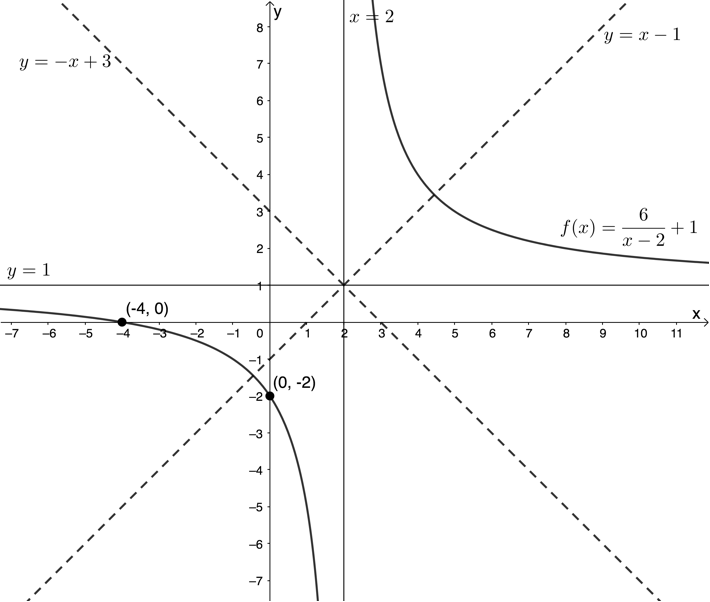
- [latex]\scriptsize g(1)=\displaystyle \frac{6}{{1-2}}+1=-5[/latex]
- Domain: [latex]\scriptsize \{x|x\in \mathbb{R},x\ne 2\}\text{ }[/latex]
Range: [latex]\scriptsize \{g(x)|g(x)\in \mathbb{R},g(x)\ne 1\}\text{ }[/latex]
- [latex]\scriptsize g(x)=\displaystyle \frac{6}{{x-2}}+1[/latex]
- .
- .
[latex]\scriptsize \begin{align*}f(x)-2 & =\displaystyle \frac{2}{{x-4}}\\\therefore f(x) & =\displaystyle \frac{2}{{x-4}}+2\end{align*}[/latex]
Vertical asymptote is the line [latex]\scriptsize x=4[/latex].
Horizontal asymptote is the line [latex]\scriptsize y=2[/latex]. - x-intercept (let [latex]\scriptsize y=0[/latex]):
[latex]\scriptsize \begin{align*}0 & =\displaystyle \frac{2}{{x-4}}+2\\\therefore \displaystyle \frac{2}{{x-4}} & =-2\\\therefore x-4 & =-1\\\therefore x & =3\end{align*}[/latex]
y-intercept (let [latex]\scriptsize x=0[/latex]):
[latex]\scriptsize \begin{align*}f(0) & =\displaystyle \frac{2}{{0-4}}+2\\\therefore f(0) & =\displaystyle \frac{3}{2}\end{align*}[/latex] - To draw an accurate sketch, we need to find the axes of symmetry.
The axes of symmetry intersect at [latex]\scriptsize (4,2)[/latex].
Substitute [latex]\scriptsize (4,2)[/latex] into [latex]\scriptsize y=x+{{c}_{1}}[/latex]:
[latex]\scriptsize \begin{align*}2&=4+{{c}_{1}}\\\therefore {{c}_{1}}&=-2\end{align*}[/latex]
Substitute [latex]\scriptsize (4,2)[/latex] into [latex]\scriptsize y=-x+{{c}_{2}}[/latex]:
[latex]\scriptsize \begin{align*}2&=-4+{{c}_{2}}\\\therefore {{c}_{2}}&=6\end{align*}[/latex]
The axes of symmetry are [latex]\scriptsize y=x-2[/latex] and [latex]\scriptsize y=-x+6[/latex].
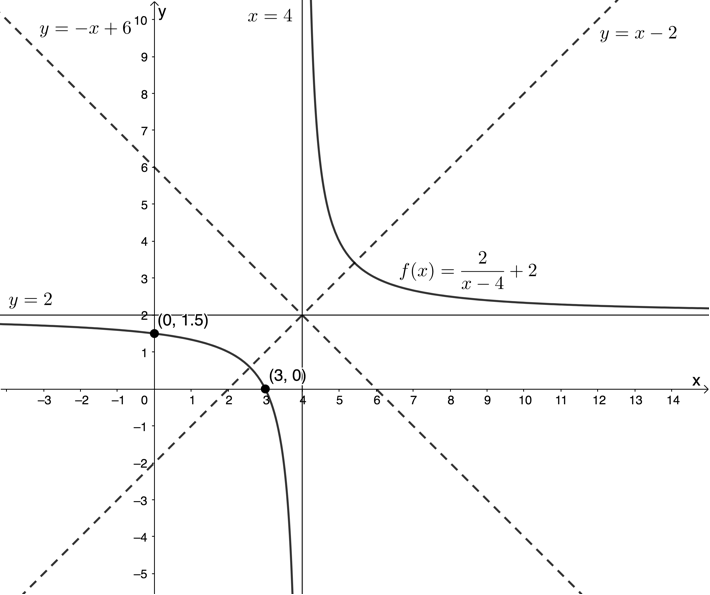
- [latex]\scriptsize f(-1) =\displaystyle \frac{2}{{(-1)-4}}+2=\displaystyle \frac{8}{5}[/latex]
- Domain: [latex]\scriptsize \{x|x\in \mathbb{R},x\ne 4\}\text{ }[/latex]
Range: [latex]\scriptsize \{f(x)|f(x)\in \mathbb{R},f(x)\ne 2\}\text{ }[/latex]
- .
Media Attributions
- figure18 © DHET is licensed under a CC BY (Attribution) license
- figure4 © DHET is licensed under a CC BY (Attribution) license
- figure3 © Geogebra is licensed under a CC BY-SA (Attribution ShareAlike) license
- figure4 © Geogebra is licensed under a CC BY-SA (Attribution ShareAlike) license
- figure5 © Geogebra is licensed under a CC BY-SA (Attribution ShareAlike) license
- figure6 © Geogebra is licensed under a CC BY-SA (Attribution ShareAlike) license
- example3.4 © Geogebra is licensed under a CC BY-SA (Attribution ShareAlike) license
- assessmentA1c © Geogebra is licensed under a CC BY-SA (Attribution ShareAlike) license
- assessmentA2c © Geogebra is licensed under a CC BY-SA (Attribution ShareAlike) license
